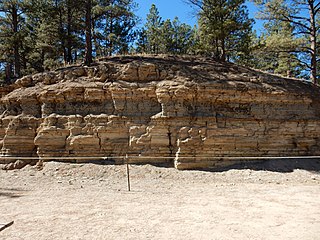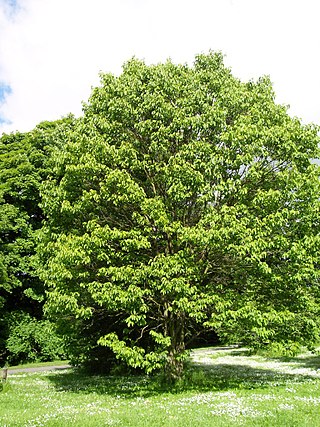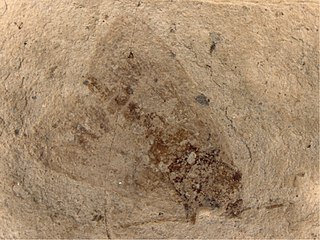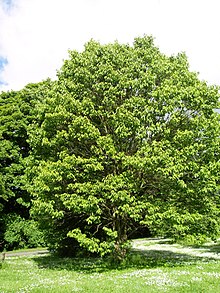
The Elaeagnaceae are a plant family, the oleaster family, of the order Rosales comprising small trees and shrubs, native to temperate regions of the Northern Hemisphere, south into tropical Asia and Australia. The family has about 60 species in three genera.

The Florissant Formation is a sedimentary geologic formation outcropping around Florissant, Teller County, Colorado. The formation is noted for the abundant and exceptionally preserved insect and plant fossils that are found in the mudstones and shales. Based on argon radiometric dating, the formation is Eocene in age and has been interpreted as a lake environment. The fossils have been preserved because of the interaction of the volcanic ash from the nearby Thirtynine Mile volcanic field with diatoms in the lake, causing a diatom bloom. As the diatoms fell to the bottom of the lake, any plants or animals that had recently died were preserved by the diatom falls. Fine layers of clays and muds interspersed with layers of ash form "paper shales" holding beautifully-preserved fossils. The Florissant Fossil Beds National Monument is a national monument established to preserve and study the geology and history of the area.

Hovenia dulcis, the Japanese raisin tree or oriental raisin tree, is a hardy tree found in Asia, from Eastern China and Korea to the Himalayas, growing preferably in a sunny position on moist sandy or loamy soils. The tree known for its health benefits when consumed in tea, introduced as an ornamental tree to several countries, also bears edible fruit. It is considered to be one of the most pervasive invaders in Brazilian subtropical forests.
Paleontology or palaeontology is the study of prehistoric life forms on Earth through the examination of plant and animal fossils. This includes the study of body fossils, tracks (ichnites), burrows, cast-off parts, fossilised feces (coprolites), palynomorphs and chemical residues. Because humans have encountered fossils for millennia, paleontology has a long history both before and after becoming formalized as a science. This article records significant discoveries and events related to paleontology that occurred or were published in the year 1936.

Herpetotherium is an extinct genus of metatherian mammal, belonging to the possibly paraphyletic family Herpetotheriidae. Native to North America from the Eocene to Early Miocene, fossils have been found in California, Oregon, Texas, Florida, Montana, Wyoming, Colorado, North and South Dakota, Nebraska, and Saskatchewan. The oldest species, H. knighti, is dated to around 50.3 mya, and the most recent, an unnamed species, may be as recent as 15.97 mya. A morphological analysis of marsupials and basal metatherians conducted in 2007 found Herpetotherium to be the sister group to extant marsupials. It is the youngest known metatherian from North America until the migration of the Virginia opossum from South America within the last 2 million years.

Florissantia is an extinct genus of flowering plants in the Malvaceae subfamily Sterculioideae known from western North America and far eastern Asia. Flower, fruit, and pollen compression fossils have been found in formations ranging between the Early Eocene through to the Early Oligocene periods. The type species is Florissantia speirii and three additional species are known, Florissantia ashwillii, Florissantia quilchenensis, and Florissantia sikhote-alinensis.

Florissantoraphidia is an extinct genus of snakefly in the family Raphidiidae containing two described species Florissantoraphidia funerata and Florissantoraphidia mortua. Both species were originally placed in the living raphidiid genus Raphidia, as Raphidia funerata and Raphidia mortua respectively. before being redescribed and transferred to the newly erected genus in 2014.

Prodryas persephone is an extinct species of brush-footed butterfly, known from a single specimen from the Chadronian-aged Florissant Shale Lagerstätte of Late Eocene Colorado. P. persephone is the first fossil butterfly to be found in North America, and is exquisitely well preserved. Its closest extant relatives are the mapwings and African admirals of the genera Hypanartia and Antanartia, respectively.
Anthidium scudderi is an extinct species of mason bee in the Megachilidae genus Anthidium. The species is solely known from the late Eocene, Chadronian stage, Florissant Formation deposits in Florissant, Colorado, USA. Anthidium scudderi is one of only four extinct species of mason bees known from the fossil record, and with Anthidium exhumatum, one of two species from the Florissant Formation.
Anthidium exhumatum is an extinct species of mason bee in the Megachilidae genus Anthidium. The species is solely known from the late Eocene, Chadronian stage, Florissant Formation deposits in Florissant, Colorado, USA. Anthidium exhumatum is one of only four extinct species of mason bees known from the fossil record, and with Anthidium scudderi, one of two species from the Florissant Formation.

Paleolepidopterites is a collective genus of fossil moths which can not be placed in any defined family. The included species were formerly placed in the leaf-roller family Tortricidae and are known from fossils found in Russia and the United States. The collective genus contains three species: Paleolepidopterites destructus, Paleolepidopterites florissantanus, and Paleolepidopterites sadilenkoi, formerly placed within the genera Tortrix and Tortricites respectively. The three species were formally redescribed and moved to the new collective genus by Heikkilä et al. (2018).

Hydriomena? protrita is an extinct species of moth in the family Geometridae, and possibly in the modern genus Hydriomena. The species is known from late Eocene, Priabonian stage, lake deposits of the Florissant Formation in Teller County, Colorado, United States. It was first described by Theodore Dru Alison Cockerell in 1922.
Dominickus is an extinct genus of moth in the butterfly-moth family Castniidae containing a single species Dominickus castnioides. The species is known from late Eocene, Priabonian stage, lake deposits near the small community of Guffey in Teller County, Colorado, United States.

Sequoia affinis is an extinct species of the genus Sequoia in the cypress family Cupressaceae.

Paleontology in Colorado refers to paleontological research occurring within or conducted by people from the U.S. state of Colorado. The geologic column of Colorado spans about one third of Earth's history. Fossils can be found almost everywhere in the state but are not evenly distributed among all the ages of the state's rocks. During the early Paleozoic, Colorado was covered by a warm shallow sea that would come to be home to creatures like brachiopods, conodonts, ostracoderms, sharks and trilobites. This sea withdrew from the state between the Silurian and early Devonian leaving a gap in the local rock record. It returned during the Carboniferous. Areas of the state not submerged were richly vegetated and inhabited by amphibians that left behind footprints that would later fossilize. During the Permian, the sea withdrew and alluvial fans and sand dunes spread across the state. Many trace fossils are known from these deposits.

Eulithomyrmex is an extinct genus of ant in the formicid subfamily Agroecomyrmecinae. The genus contains two described species, Eulithomyrmex rugosus and Eulithomyrmex striatus. Eulithomyrmex is known from a group of Late Eocene fossils which were found in North America.

Archiponera is an extinct genus of ant in the formicid subfamily Ponerinae. The genus contains a single described species, Archiponera wheeleri known from several Late Eocene fossils which were found in North America.
Priabona is an extinct genus of big-headed flies in the dipteran subfamily Nephrocerinae, within which it is one of only two genera. The genus contains a single described species, Priabona florissantius. Priabona is known from a single Late Eocene fossil from western North America.

Calyptapis is an extinct bombini genus related to bumblebees with one described species Calyptapis florissantensis. It is known only from the Late Eocene Chadronian age shales of the Florissant Formation in Colorado. The genus and species were described by Theodore Dru Alison Cockerell in 1906.

Florissantia is an extinct monotypic genus of planthopper in the dictyopharid subfamily Dictyopharinae. The single species, Florissantia elegans, was described by Samuel Hubbard Scudder (1890) from fossils found in the Florissant Formation of Colorado.
















